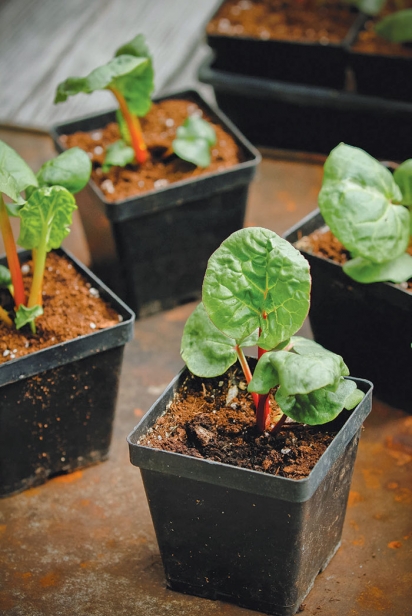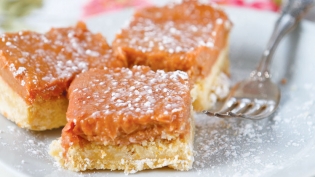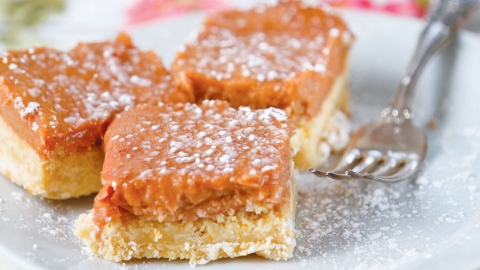Rhubarb Rising
Rhubarb. The very name connotes a plant that is awkward and unsophisticated. At best, it is a marginal player among commercial crops, grabbing a modicum of attention in spring before strawberries steal its thunder.
Grandma and Aunt Myrna cook with rhubarb but, aside from their delicious pie, many can’t really summon up other uses for it. Some people can’t even seem to classify it, arguing whether it is a fruit or a vegetable. The leaves of rhubarb are not only inedible but toxic to humans in high doses. Furthermore, it is a space hog in the garden, grabbing up nutrients and light from its neighbors and refusing to budge for years.
Everyone is happy to see rhubarb show up in the market because it means spring is really here—but does anyone truly love rhubarb?
I do. I believe rhubarb has a myriad of uses in both sweet and savory dishes and is on the verge of being the next culinary darling. It will be the pomegranate of 2015, the new acai berry. I am such a believer in rhubarb that even after scaling back commercial crops on my farm, I have started about a quarter acre of rhubarb with plans to expand as the plants mature. In doing some research on it, I have discovered it has a storied history in Europe and Asia and new studies reveal it will have a hand (OK, a leaf) in saving the planet. It even has a role in the performing arts. Rhubarb may be unsophisticated, but I predict it will soon have its day.
For the record, rhubarb is botanically a vegetable but according to a New York court decision in 1947, since it is primarily used in pie, the United States has deemed it a fruit, scientific taxonomy be damned. (This was determined for tariff reasons since fruit and vegetable imports are taxed differently.) Originally from Asia, rhubarb was imported to Europe along the Silk Road and became a popular ingredient, particularly in England where it grows very well. In fact, an area of intense cultivation called the Rhubarb Triangle in West Yorkshire was recently awarded Protected Designation of Origin status by the European Commission, an honor given to such elite products as Parmesan cheese and Champagne.
Rhubarb came to the New World with the settlers and was established as they made their way from Maine to the Pacific. The largest commercial crops can now be found in Washington and Oregon, where the cool, moist climate is conducive to excellent growth. It remains a stalwart here in New England, however, and most gardeners will place at least one plant among their perennials since it is so easy and dependable.
The best way to propagate rhubarb is to dig up a mature, healthy plant and divide it. Since they need to be divided every three years or so, it is likely you can find a neighbor with a plant that she wants to cut back. Dig it up in spring when the soil is still soft and the leaves are dormant or small. You can try to be precise about your cut but the truth is you are going to have to whack at it with a shovel if it is a large root. Look for a section that has some buds protruding and slice away. Replant the root section in rich soil, filled with compost, giving it two feet in either direction and cover until just the buds are poking through. Water well and fertilize in a few weeks.
I have a few rows from divisions but since I planned for about 200 plants, I also attempted growing them from significantly less expensive seed last spring. I planted the seeds in an organic growing medium in late February and kept them well watered until they came up 10 days later. I did my best to keep them in enough sunlight in the house until I transferred them to the unheated greenhouse in April. They were planted out into the field in late May and most of them held on for the season.
Being my first time from seed, I didn’t know what to expect but was gratified to see how much growth they put on in their first year. Nevertheless, I won’t be able to harvest the plants from seed for three years, whereas the ones propagated from divisions should be ready in a year or two.
The use of rhubarb in pies and cakes is well known but it is also a delicious addition to drinks. It is one of the few disclosed ingredients in the Italian aperitif, Aperol. With cocktails making a big comeback, Aperol is showing up in well-stocked bars again and its parent company, Campari, has released a premixed version of the Aperol Spritz, made famous during Hemingway’s time. If you want to create your own cocktails, start by making a simple syrup infused with rhubarb by boiling rhubarb, water and sugar together and then straining it. Use the syrup in lemonade, plain seltzer or with puréed strawberries for an afternoon treat. Add all of the above with rum to make it an evening treat.
I would be remiss if I did not mention again that the leaves of rhubarb contain oxalic acid, which is toxic and should be cut off and left behind in the garden. Also, do not eat the stalks after a hard frost as the oxalic acid will travel from the leaf down the stalks as it dies back. If a little bit of leaf ends up in the pie, however, do not worry. It is estimated that it would require about 11 pounds of leaves to accumulate a lethal dose for the average-sized human being.
The natural acids in the stalks that make you pucker are also quite powerful, measuring a pH of 3.2 (that’s vinegar territory). The upside to that fact is that rhubarb pulp is known to be a very good cleanser. David Boyden of Boyden Winery in Cambridge, VT, reports his stainless tanks are never so clean as when he finishes producing a batch of rhubarb wine.
Scientists at Yale University have recently discovered an even more important application of rhubarb’s peculiar makeup. When CFCs (chlorofluorocarbons) were banned in 1996 due to their proclivity to cause holes in the earth’s ozone layer, the U.S. was left with huge stockpiles of CFCs, which no one knew what to do with since they are not easily reduced to more benign components. Chemists from Yale discovered that mixing the CFCs with the sodium oxalate found in rhubarb leaves would safely and economically reduce the CFCs to a harmless carbon compound, table salt and sodium fluoride. A marginal player? Try superhero.
Lastly, you may be curious how rhubarb is involved in the performing arts. It has long been a useful bit of dialog in movies and radio. If one is cast as an extra, say at a party, the players are sometimes instructed to say back and forth to each other, “Rhubarb, rhubarb” which sounds, in aggregate, like indistinctive background conversation. This has nothing whatsoever to do with its qualities as an ingredient but, as I explained, I am now full to the brim with rhubarb factoids and this is one of my favorites.
Given how long it has been cultivated and enjoyed, rhubarb trivia is extensive but the most important fact is that it is delicious. Keep your eyes open for other new culinary applications of rhubarb this coming season and remember, when it becomes the next “it” ingredient—you heard it here first.








